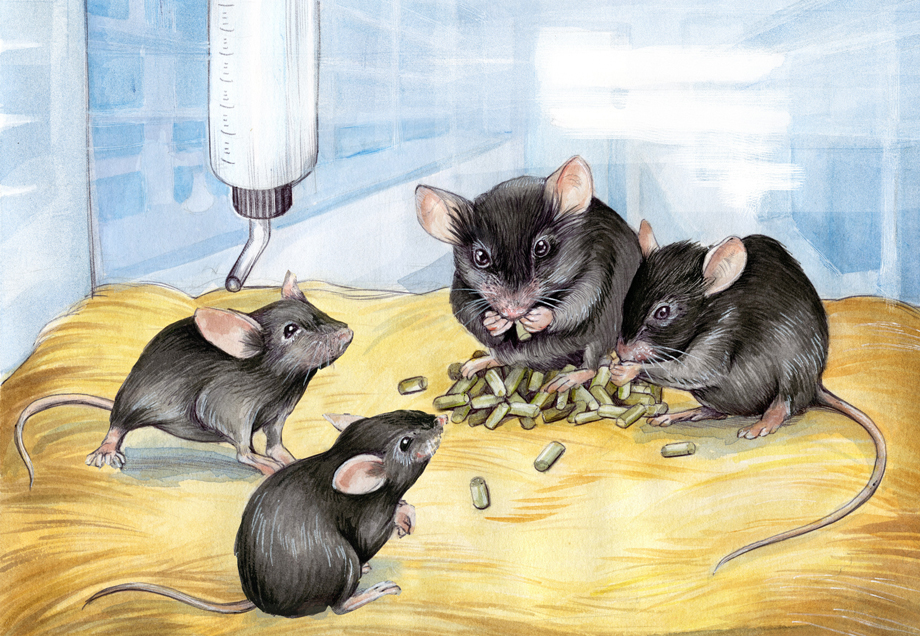
THIS ARTICLE IS MORE THAN FIVE YEARS OLD
This article is more than five years old. Autism research — and science in general — is constantly evolving, so older articles may contain information or theories that have been reevaluated since their original publication date.
Living with a larger cagemate can cause mutant mice to be quiet around females and forget whether and where they’ve seen an object before — autism-like behaviors that researchers may misinterpret as originating from the mutation1. This sobering result, published 15 April in Physiology of Behavior, should serve as a cautionary tale for scientists studying behavior in mice, experts say.
The findings surfaced during a study of mice missing an autism-linked segment on chromosome 16. The mice are as small as half the size of controls. When they have cagemates of normal size, the mice are shy and have memory problems. But if two mutant mice live together in a safe space, these problems disappear, says lead researcher Mu Yang.
“If you have two little runty guys living with two bigger guys, how can there not be problems with bullying?”
“If you have two little runty guys living with two bigger guys, how can there not be problems with bullying?” says Yang, assistant professor of psychiatry and behavioral sciences at the University of California, Davis.
The study could have broad implications for behavioral research in mice: Roughly 30 percent of ‘knockout’ mice — those lacking one or more genes — housed at The Jackson Laboratory, a nonprofit repository for mouse models in Bar Harbor, Maine, are abnormally small2.
Researchers rarely reveal details in their papers of their mice’s living conditions, says Stacey Rizzo, associate director of the neurobehavioral core at Jackson Labs. “The things that some people might think of as minutiae, like how the animals are housed, are critical.”
Cage fighting:
The findings emerged when Yang and her colleagues studied mice missing 16p11.2, a swath of DNA on chromosome 16 that has been linked to autism.
Earlier this year, the same team reported that male mice with the deletion emit fewer high-pitched squeaks to females in their cages than control mice do3. This finding hinted that the mice also model the language impairments seen in some people with the deletion.
The new study has thrown a wrench into this narrative: It suggests that some of the observations in these mice are the result not of the mutation, but of the mutant mice being social subordinates to their normal cagemates.
“Animals don’t know how to be nice to each other,” Yang says. “In humans, if you’re bigger than me, you’re not necessarily mean. But in the animal kingdom — especially in males — if you’re the runt, the chance that you’re the subordinate is pretty big.”
Clues that the cage environment may alter mouse behavior emerged when Yang tried to reduce the mice’s weight by limiting their food for an experiment that hinges on food bribes. The mutant mice starved, but the control mice maintained their weight. This suggests the controls were bullying the mutant mice out of their share of the food.
To counter this problem, the team set up cages with only mutant mice. Yang later asked a student to practice behavioral assays with these mice, but the student could not replicate the team’s previous results. That eventually led the researchers to discover the powerful impact of the cagemates’ size.
Researchers often pair up mutant mice with their non-mutant littermates to serve as controls for their experiments. A 2011 study found that members of another strain of mice, called BTBR, are more likely to sniff other mice when they live with controls, suggesting that cagemates can influence sociability3.
The best way to conduct behavioral experiments in mice may be to test the mice in both scenarios: with mutants and with controls, says Thomas Portmann, senior scientist at Circuit Therapeutics in Menlo Park, California, who developed the mice.
“There’s a danger that people now think that these mouse models are useless, but it’s the opposite,” Portmann says. “It is a huge opportunity to try to dissect carefully what autism symptoms could be related more to environment than to genetics.”
In any case, the results indicate that analyzing mouse behavior is tricky. Mice with a 16p11.2 deletion made in a different lab are also smaller than their peers, but they don’t seem to be socially subordinate, says Joanna Pucilowska, a postdoctoral researcher in Gary Landreth’s laboratory at Case Western Reserve University in Cleveland, Ohio. However, she says, the mice seemed terrified of loud noises that accompanied their lab’s renovation: They froze completely and couldn’t participate in certain experiments; control mice were unaffected.
Yang plans to repeat her experiments in these and other mouse models of autism. “I’m really curious to see if the deficits will hold or disappear in the [other 16p11.2] line,” she says. “I do think that behavioral deficits in many studies may have been affected by social environment.”
References:
1: Yang M. et al. Physiol. Behav. Epub ahead of print (2015) PubMed
2: Reed D.R. et al. BMC Genet. 9, 4 (2008) PubMed
3: Yang M. et al. Autism Res. Epub ahead of print (2015) PubMed
4: Yang M. et al. Autism Res. 4, 17-27 (2011) PubMed
By joining the discussion, you agree to our privacy policy.